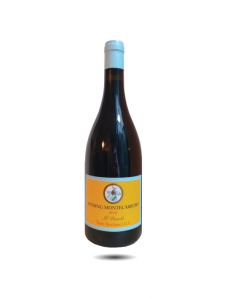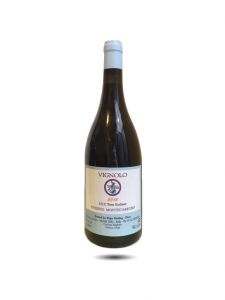We use cookies to make your experience better. To comply with the new e-Privacy directive, we need to ask for your consent to set the cookies. Learn more.
Peter Vinding-Diers

I have known Peter and Susie Vinding Diers for almost thirty years and their two sons as well as their cousin Peter Sisseck of Pingus fame, are all talented winemakers in their own right. Peter has made wine all over the world and has now chosen Sicily as his new home. Apart from being an expert on yeast strains, he is known for the wines he has made in South Africa, Bordeaux and Hungary. He was also a founding member of the Royal Tokaji Wine Company in Hungary, which produces fabulous sweet wines. When I was studying for the Master of Wine exam he was a great mentor to me.
In 2005 Susie and Peter bought a small piece of wilderness with some unkempt olives and a few lacerated almond trees” to quote Peter who describes the estate as follows: “Montecarrubo is a piece of a volcano, extinct some two million years ago. Half of it looked ready to plant, but the other half was full of huge boulders and pieces of rock. It was herding land and had been grazed over for hundreds of years. However the location is perfect. In full view of the Ionian Sea to the east, the land slopes gently towards the water while if you look north, the huge cone of Etna looms over the neighbours’ lemon trees and to the west is a long low canyon, with wild olives on the slopes. The south is dominated by the mountain village hanging on the Iblea range on top of a grotto, which had furnished all the limestone for the houses in the village in the past. Cool breezes blow in from the sea. This is the Gregale that originates in Siberia but comes from Greece. Even during the hottest days in July and August, it helps cool down the property, ideal for a vineyard!
The soil was another important point for planting an optimal vineyard here. Loess, washed out volcanic clay, mixed with limestone on a limestone base, and to the West, the remains of a coral reef. Two million years ago our Volcano was lying in the middle of a tropical Sea, but research has found that it was a sweet water volcano. The pH is 7,5 and we sank a bore hole some130 meters to get two liters a second, clean and drinkable. We wrestled one and a half hectare out of the rocky land where the soil was meter deep full of humus and oxygen rich soil: just the right place to plant our Syrah vineyard.
Syrah, because it does so well on the Island, and our friend Pierre Marie Guillaume gave us a wonderful multi clone, specially selected and grafted for us. The wines show differently than any other Syrah we have tasted here; rich in minerals, very pure with reminders of the wild herbs around us and of their own terroir. We have fermented these wines on their own yeast (which is a huge part of any terroir) and we keep them apart from the other wines we get from rented vineyards. We planted at a spacing of 1,40 x 1,40 that gives us some 5,000 vines per hectare so that we could cross cultivate. The vines are trained as bush a vine, which is more work, but also better quality. We hand work them, but use a tractor for the cultivation. We also use the principles of biodynamic cultivation because we believe in the results you get when you respect nature: stronger resistance to diseases, concentrated flavors and strong vine trunks.
We use 225 liters Bordeaux Oak barrels which we buy from a Grand Cru Classé in Bordeaux, and we also use 600 liter “demi muids “which we get from a great cooper in Pomerol. During the maturation the different coopers barrels show different results, which after a few months become very noticeable and we move the different lots of wine around to find the taste factors we want. This is very exiting work and sometimes – when it works out right – it gives a great satisfaction. The wines take time and they develop through the years, whereas the olive oil we make from our secular trees is another story. We harvest the olives using hand rakes and take them to the mill at around midday. The miller then crushes them and a few hours later he comes towards us holding a big flat slice of country bread on which he pours the new oil. Then some grains of Sea salt and we draw the cork of our new wine. Now everybody at the mill are smiling and nodding at us. The bottle is empty, the oil is dripping and we all raise our glasses to the newborn harvest….
In 2005 Susie and Peter bought a small piece of wilderness with some unkempt olives and a few lacerated almond trees” to quote Peter who describes the estate as follows: “Montecarrubo is a piece of a volcano, extinct some two million years ago. Half of it looked ready to plant, but the other half was full of huge boulders and pieces of rock. It was herding land and had been grazed over for hundreds of years. However the location is perfect. In full view of the Ionian Sea to the east, the land slopes gently towards the water while if you look north, the huge cone of Etna looms over the neighbours’ lemon trees and to the west is a long low canyon, with wild olives on the slopes. The south is dominated by the mountain village hanging on the Iblea range on top of a grotto, which had furnished all the limestone for the houses in the village in the past. Cool breezes blow in from the sea. This is the Gregale that originates in Siberia but comes from Greece. Even during the hottest days in July and August, it helps cool down the property, ideal for a vineyard!
The soil was another important point for planting an optimal vineyard here. Loess, washed out volcanic clay, mixed with limestone on a limestone base, and to the West, the remains of a coral reef. Two million years ago our Volcano was lying in the middle of a tropical Sea, but research has found that it was a sweet water volcano. The pH is 7,5 and we sank a bore hole some130 meters to get two liters a second, clean and drinkable. We wrestled one and a half hectare out of the rocky land where the soil was meter deep full of humus and oxygen rich soil: just the right place to plant our Syrah vineyard.
Syrah, because it does so well on the Island, and our friend Pierre Marie Guillaume gave us a wonderful multi clone, specially selected and grafted for us. The wines show differently than any other Syrah we have tasted here; rich in minerals, very pure with reminders of the wild herbs around us and of their own terroir. We have fermented these wines on their own yeast (which is a huge part of any terroir) and we keep them apart from the other wines we get from rented vineyards. We planted at a spacing of 1,40 x 1,40 that gives us some 5,000 vines per hectare so that we could cross cultivate. The vines are trained as bush a vine, which is more work, but also better quality. We hand work them, but use a tractor for the cultivation. We also use the principles of biodynamic cultivation because we believe in the results you get when you respect nature: stronger resistance to diseases, concentrated flavors and strong vine trunks.
We use 225 liters Bordeaux Oak barrels which we buy from a Grand Cru Classé in Bordeaux, and we also use 600 liter “demi muids “which we get from a great cooper in Pomerol. During the maturation the different coopers barrels show different results, which after a few months become very noticeable and we move the different lots of wine around to find the taste factors we want. This is very exiting work and sometimes – when it works out right – it gives a great satisfaction. The wines take time and they develop through the years, whereas the olive oil we make from our secular trees is another story. We harvest the olives using hand rakes and take them to the mill at around midday. The miller then crushes them and a few hours later he comes towards us holding a big flat slice of country bread on which he pours the new oil. Then some grains of Sea salt and we draw the cork of our new wine. Now everybody at the mill are smiling and nodding at us. The bottle is empty, the oil is dripping and we all raise our glasses to the newborn harvest….






